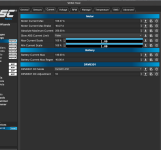leoms
1 mW
I have a custom made mid-drive bike. When I punch the throttle at low speed, there's a loud popping noise and the motor, I believe, jumps/backfires/skips. After being too casual about this, I discovered smoke coming off of a blackened-looking stator post (sorry if that's the wrong word, the thing the winding is around on the stator). This happened the day after I bought it so the guy I bought it from kindly replaced the motor. It's still happening with the new motor so I'd like to fix it before I burn another motor.
Bike's got approximately this motor. No sensor. It's supposedly rated for 150A max, 7NM torque. Controller is a Flipsky 75100 w/ aluminum board, which is rated for 120A burst. Battery pack is supposed to be able to dump around 80 amps.
I bought it from someone who had set up the controller as so. Attaching a screenshot of the whole motor current page in case you want more info, and I can send a screenshot of any other settings too.
Motor current max: 160.27
Absolute max current: 250A
Battery current max: 140A
So the motor may be getting 10A more than it can handle. Could that be the problem? I think I'll reduce these numbers to protect the batteries anyways, but I'm also curious to understand.
Any idea what's going on? Thanks!
Bike's got approximately this motor. No sensor. It's supposedly rated for 150A max, 7NM torque. Controller is a Flipsky 75100 w/ aluminum board, which is rated for 120A burst. Battery pack is supposed to be able to dump around 80 amps.
I bought it from someone who had set up the controller as so. Attaching a screenshot of the whole motor current page in case you want more info, and I can send a screenshot of any other settings too.
Motor current max: 160.27
Absolute max current: 250A
Battery current max: 140A
So the motor may be getting 10A more than it can handle. Could that be the problem? I think I'll reduce these numbers to protect the batteries anyways, but I'm also curious to understand.
Any idea what's going on? Thanks!


